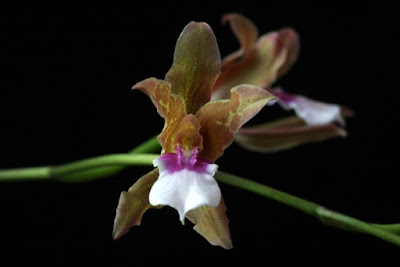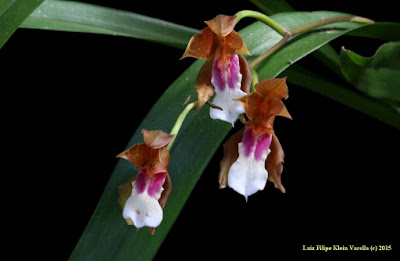Miltonia russelliana is occurring in southeastern and southern Brazil. It grows epiphytic on trees at an altitude of 900 to 1400 meters above sea level...
Miltonia russelliana also called as Russell's Miltonia, Anneliesia russellianum, Gynizodon russelianus, Miltonia quadrijuga, Oncidium russellianum, is a species of the genus Miltonia. This species was described by John Lindley in 1841.
IDENTIFY MILTONIA RUSSELLIANA
Miltonia russelliana is occurring in southeastern and southern Brazil. It grows epiphytic on trees at an altitude of 900 to 1400 meters above sea level.
It is a small to medium sized, warm to cool growing epiphyte with dull olive-green, ovate-oblong, laterally compressed, closely set, 7 cm long pseudobulbs enveloped basally by 1 to 2 leaf-bearing sheaths and carrying 2 apical, linear-oblong to linear-lanceolate, 35 cm long and 2.5 cm wide leaves.
Russell's Miltonia blooms on an erect or arching, mottled with dull purple, 60 cm long, 5 to 9 flowered, dull purple mottled inflorescence with brown sheathing bracts and flowers that occur in the fall and winter. The flowers are chestnut-brown (mixture of light and dark), not fully open, about 4 cm in diameter. Tepals grow arched forward. The lip is white, with two red (less often pink) spots in the middle. The column is white or yellow with a red speck on the tip, reaching up to 0.8 cm in length.
MILTONIA RUSSELLIANA CARE AND CULTURE
Cultural information should only be used as a guide, and should be to be adapted to suit you. Your physical location; where you grow your plants, how much time you have to devote to their care, and many other factors, will need to be taken into account. Only then can you decide on the cultural methods that best suit you and your plants.
Light:
Miltonia russelliana is grow in bright scattered light. Oriental orientation windows are considered to be the ideal location, however, if there are none in the apartment, you can use western or very bright northern windows. If the western or southern windows were chosen for the location of the plant, then during the period from May to early September, the orchid should be protected from the influence of too bright day and evening sun - put behind a curtain (for example, on a table near a window) or into the shade of other plants.
Temperature:
This kind of orchid refers to a moderate temperature regime, however, it can calmly adapt to a colder content. It is recommended that plants be kept under the following temperature conditions throughout the year: Day temperature at 15-25 ° C (ideally 15-18 ° C); Night temperature not below 14 ° C. For the successful cultivation at home, it is necessary that the night temperature of the contents always be at least 4 ° C lower than the daytime temperature.
Humidity:
Russell's Miltonia needs the humidity level that not fall below 55-60% (ideally 70-75%). Too dry air negatively affects the overall development of the plant - its growth is inhibited, leaves turn yellow and various deformations of new shoots appear.
Substrate, growing media and repotting:
Miltonia russelliana can be grow in pots and hanging baskets and placed on blocks. As a substrate, a mixture of bark of coniferous trees with charcoal is best. At the bottom of the pot is recommended to lay a thick layer of drainage. When growing orchids on blocks to prevent rapid drying of the root system of the plant, it is recommended to make a small interlayer of moss between it and the block. Above the roots, you can also put live or dry sphagnum.
Watering:
Watering this kind of orchids directly depends on the total temperature of the content, the higher it is, the more often and abundant it will be necessary to water. Plants growing on blocks should be watered daily in the morning, so that by evening the roots of the orchids could dry out relatively well. When watering orchids in pots, it is necessary to remember that excess water during watering should flow freely out of the pot, as the stagnation of water both inside the pot and in its pallet can very quickly lead to rotting of the roots and the lower part of the plant. The substrate between waterings should dry well, but in no case is more than two days completely dry.
Fertilizer:
During the new growth period, this type of orchid is fertilized every 2 weeks in 1/2 of the fertilizer concentration indicated on the package. In addition to the usual root top dressing, it is also recommended to produce a foliar dressing, when a very much diluted fertilizer is sprayed on the outer part of the plant. It is best to feed the orchid, alternating both these methods. At the beginning of the growing season (the appearance of new shoots) it is recommended to use a fertilizer with a high nitrogen content, and by the time when new shoots reach 1/2 of their normal size - a fertilizer with a high content of phosphorus.
Rest period:
To stimulate the flowering Miltonia russelliana needs a clearly defined period of rest. It begins immediately after the maturing of new shoots (late September - early October), i.e. when new young shoots reach the size of old ones and begin to turn into full-fledged pseudobulbs (rounded), and consists in the fact that orchids contain somewhat drier and colder than usual and do not fertilize. The total temperature of the contents can vary between 16-18 ° C in the daytime and 14-15 ° C at night. Watering the orchids should be stopped completely, while increasing the humidity of the air to 75-90%, as an alternative, it is also possible to spray the outside of the plant (leaves) daily (in the morning), avoiding water entering the substrate. The signal for the resumption of irrigation is the appearance of peduncles, the appearance of new shoots or extremely wrinkled pseudobulbs. An increase in the total temperature of the content for the flowering period is not recommended. Refusal to flowering orchids can be caused by non-observance of the rest period, its improper conduct or stressful plant condition (poor root system, insufficient lighting, too hot content, etc.).















COMMENTS